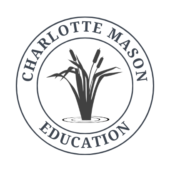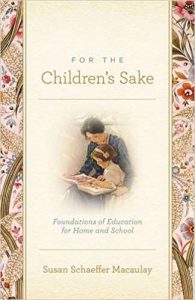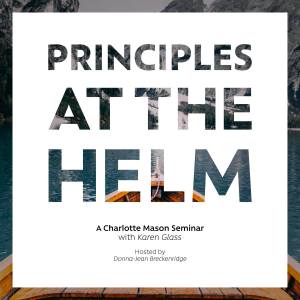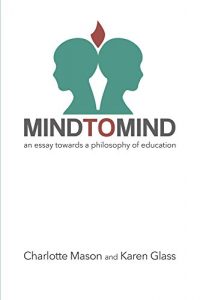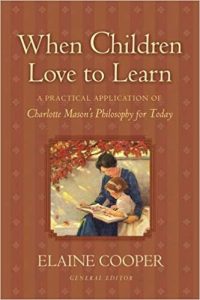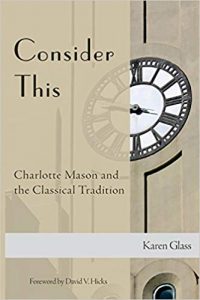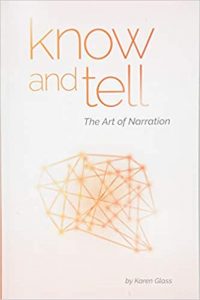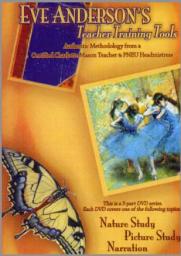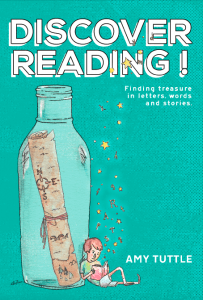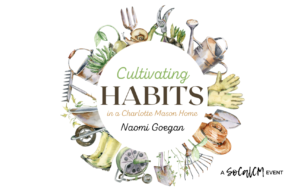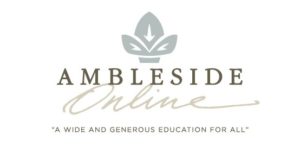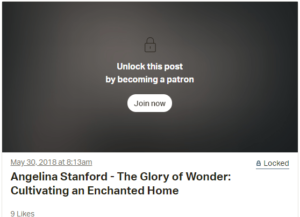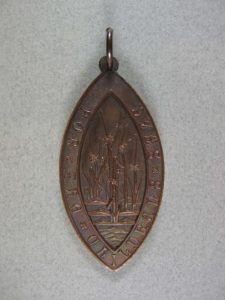Resources are a changing and evolving landscape with new books, videos, posts, podcast episodes, etc. coming out all the time. This page contains what we believe are quality resources along with source documents to help you learn about Charlotte Mason’s method of education. It is in no way comprehensive but we hope will help you along the way. If you have resources to recommend that you believe should be on this page, please contact us.
Getting Started
If you’re short on time and need to get started ASAP, visit our Getting Started Page. Make sure to continue learning as you go. Applying CM’s methods without an understanding of her underlying philosophy can lead to an entirely different education.
Who is Charlotte Mason?
Charlotte Mason was a late 19th/early 20th century educator whose ideas and methods have inspired and informed educators anew. She wrote six volumes, now titled “The Original Homeschooling Series,” which outlined her thoughts on education and documented the success of her methods when applied as an integrated whole. Her ideas took hold in the US in the 80s when Susan Schaeffer Macaulay published her book, For the Children’s Sake. She is quickly becoming a household name in homeschooling circles today and for good reason, her methods are beautiful, resonate truth, and are enjoyable for both parent and child alike.
What is a Charlotte Mason Education?
A Charlotte Mason education is one that respects the child as created in the image of God. It assumes and builds upon the child’s existing interest in God, the universe around him, and the history of man by providing an abundant feast of truth, goodness, and beauty in a genuine atmosphere of learning. It is an education that grows children into healthy self-direction and competent adulthood with a vitality and magnanimity for life.
A great place to start learning is on AmblesideOnline’s An Introduction to Charlotte Mason page. It is a one-page description of what CM is and is not.
Is Charlotte Mason the same as Wild & Free? This series is very helpful in seeing the similarities and differences between the two.
Where Can I Learn the Fundamentals of a Charlotte Mason Education?
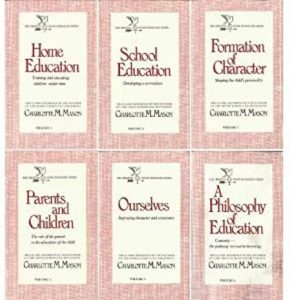
The Original Home Schooling Series by Charlotte Mason – This is her six-volume book series. Written in the late 1800s, these are her direct words. The English is challenging, but well worth the time to work through them. Thanks to the AmblesideOnline Advisory and countless volunteers, the full text is available online for free here. A Modern English version is here.
For the Children’s Sake: Foundations of Education for Home and School by Susan Schaeffer Macaulay – the groundbreaking book written by Francis Schaeffer‘s daughter that brought Charlotte Mason’s ideas to modern America. Still a classic and great first book for those new to CM.
Principles at the Helm – an excellent three-part, 90-minute audio seminar covering Charlotte Mason’s essential, foundational ideas. A dialogue between Karen Glass and Donna-Jean Breckenridge.
Mind to Mind
For many, Charlotte Mason’s six volumes can be challenging to read. Not only were they written over 100 years ago, leaving us wondering over context, she breaks off into poetry mid-sentence to describe a thought and casually references characters from Sir Walter Scott and Thackeray’s writing familiar to those of that time to make her points. But her words are still striking when we can read them directly. Thankfully, Karen Glass has made them more accessible in Mind to Mind.
With surgeon-like precision, and a keen eye and deep respect for the original and to remain true to Charlotte Mason’s intended meaning, Mind to Mind brings the essential philosophy into sharp relief. “The message for our age is, Believe in mind, and let education go straight as a bolt to the mind of the pupil.” Our generation needs to hear that message more acutely than ever.
This book is an abridgment in the literal Latin sense of “to shorten.” What has been shortened is not merely the length of the original volume, but the path between the modern reader and the mind of Charlotte Mason.
When Children Love to Learn: A Practical Application of Charlotte Mason’s Philosophy for Today – individualized chapters explaining each of Charlotte Mason’s ideas and methods – a great CM reference book for the bookshelf.
Consider This: Charlotte Mason and the Classical Tradition by Karen Glass.
While disputes over the classical-ness of Charlotte Mason’s methods lumber on, Consider This explores Charlotte Mason’s own writings and expansive reading on the the subject. Modern homeschoolers are helped in discerning the underlying ideas and philosophies of consequence and how they are fleshed out in today’s curriculum choices. “The classical tradition as it informs teaching is good not because it is old or ‘classical,’ but because it works; and what works, whether old or new, is best. That’s the Mason message admirably conveyed by Karen Glass.” —David V. Hicks, author of Norms & Nobility: A Treatise on Education.
Know and Tell: The Art of Narration is the definitive book demystifying narration: the indispensable method underlying Charlotte Mason’s educational philosophy. Drawing from real-life students and examples including graduates with immense composition skill resulting from years of narration practice, Know and Tell outlines the entire process in a practical way accessible to all. Realistic expectations are addressed as well as age related transitions from oral to written narrations and upper level composition.
Eve Andersen Teacher Training Tools DVD
Eve Andersen, a trained PNEU (Charlotte Mason’s School) Headmistress was filmed in three classroom sessions – Nature Study, Picture Study, and Narration to help teach how to implement these aspects of a CM education in a classroom setting. The set of 3 DVDs is available for $30 here.
The Theology of CM
Is a Charlotte Mason education “Christian”? Yes. She was part of the Church of England which was Anglican in her time. You can read more about her theology here. After a cursory reading of Charlotte Mason’s chapter on the Good and Evil Nature of a Child, along with a lack of knowledge that people of her time believed children inherited behaviors like stealing and drunkenness, people often mistake Charlotte Mason’s statement that “Children are not born bad but with possibilities for good and for evil.” to mean that she didn’t believe children were born with Original Sin. This is untrue. Did Charlotte Mason Believe in Original Sin? is a post covering a discussion on this issue.
Wasn't CM an Evolutionist?
Charlotte Mason believed in Evolution, it’s true. And if she lived today, that would mean she is an atheist, but she lived in a different time and at that time, when evolution was introduced to the world, it didn’t begin as a science that was incompatible with faith like it is today. In fact, many of the theologians of England in her time also believed in evolution. This article by Karen Glass is a great resource that discusses Charlotte Mason’s views and evolution.
“Let us first of all settle it with ourselves that science and religion cannot, to the believer in God, by any possibility be antagonistic. Having assured ourselves of this, we shall probably go on to perceive that the evolution of science is in fact a process of revelation, being brought about in every case, so far as I am aware, by the process which Coleridge has so justly described; that is, “that the Ideas of Nature, presented to chosen minds by a higher power than Nature herself, suddenly unfold as it were in prophetic succession systematic views destined to produce the most important revolutions in the state of man.” Huxley defines the utility of Biology “as helping to give right ideas in this world, which is, after all,” he goes on to say, “absolutely governed by ideas, and very often by the wildest and most hypothetical ideas.” Again, he writes, “those who refuse to go beyond the fact rarely get as far as the fact; and anyone who has studied the history of science knows that almost every great step therein has been made by the ‘anticipation of nature,’ that is, by the invention of hypotheses.” One cannot help thinking that scientific men would find the unifying principle they are in search of in the fine saying of Coleridge’s which I have quoted more than once or twice; so would they stand revealed to themselves as the mouthpieces, not merely of the truth, for which they are so ready to combat and suffer, but also as the chosen and prepared servants of Him who is the Truth.” ~Charlotte Mason, School Education p.157
CM for Preschool Aged Children
Charlotte Mason recommended waiting to begin formal schooling until a full 6 years of age. Parents often want to rush in and begin early feeling their child is showing readiness, but there is a lot that can be done with a preschool age child without beginning formal schooling.
Parents are Peacemakers 6 Talks by Essex Cholmondeley. Intended for group discussion, but can be read independently if necessary.
AmblesideOnline’s wonderful explanation of what pre-school years should look like.
A Living Preschool – a downloadable guide for parents of preschoolers.
Picture Book List – Books you can read in the younger years. Be selective at this age! Especially if you are randomly picking books at the library – not all library books are good for your kids! You are paving the way for literary learning. Raising them up on ‘twaddle’ will not serve them well in the years to come.
The Literature of Honor for Little Boys is a wonderful list by Cindy Rollins. There are many, many other popular lists out there you can learn about, these are not exhaustive.
Teaching Children to Read
Joyful Shepherdess’ posts on teaching children to read using CM’s methods compiled in one google doc is a free resource to help you teach your child to read.
Discover Reading! authored by AmblesideOnline Auxiliary member Amy Tuttle, outlines a Charlotte Mason approach to teaching your child to read. With its teacher guide, activities and example lessons, Discover Reading! will help you: grasp and apply Charlotte Mason’s principles, develop your child’s skills in phonemic awareness, blending, word-building, visualization, word-analysis and automaticity in word recognition, and encourage a love for language and stories using interesting activities filled with inspiring ideas.
Habits & The Will
Cultivating Habits in a Charlotte Mason Home – a one-hour session on habits specific to the ideas of Charlotte Mason but beneficial to anyone interested in understanding the power of habit in the life and education of a child.
Two posts on Afterthoughts by Brandy Vencel gives step by step instructions of Charlotte Mason’s method of Habit Training. Habit Training Part I Habit Training Part II
Habits & The Will is a brief talk outlining Charlotte Mason’s ideas on habits, authority in the home, and how the child’s own will is invited in self-discipline.
Additional posts on a disciplined will and the habit of attention can be found here and here.
Charlotte Mason had a motto for her students to teach them: I am, I can, I ought, I will.
You can read more about habits and Charlotte Mason’s ideas on Education is a Discipline here, here, here, and here.
Forms (Years/Grades)
As you read Charlotte Mason’s writings you will find that her school years were organized by Forms, here’s how AmblesideOnline translates them to American school years:
IB (age 6), 1 year, roughly grade 1
IA (age 7-9), 2 years, roughly grade 2 and 3
Form II (roughly grades 4-6)
IIB (age 9), 1 year, roughly grade 4
IIA (age 10-12), 2 years, roughly grade 5 and 6
Form III and IV (roughly grades 7-9)
Form V and VI (roughly grades 10-12)
The Practical Working Particulars
This pamphlet is an original document of Charlotte Mason’s schools outlining the “Practical Working Particulars” including timetables to help parents understand what they did and how it can or can’t apply to their modern family. Courtesy of Karen Glass, AmblesideOnline Advisory Member.
Scheduling (Timetables)
AmblesideOnline’s Scheduling Page explains CM scheduling and its particulars.
Here are some of Charlotte Mason’s original “timetables” from a booklet “The Practical Working Particulars of the PNEU, the PUS and the House of Education” dated 1928-1933. The notes to these timetables say that Music, Handicrafts, Field Work, Dancing, Nature NoteBooks, and Century Books, are taken in the afternoons, so they wouldn’t have been part of the timetables here. It also says that the lighter portions of the Literature, verse, play or poems are read for amusement in the evenings and also in the holidays. There are also 6 days a week on these timetables – Saturdays included, and we know Charlotte Mason talked about Sunday reading as well.
Not every family’s schedule will fit this school mold. When you understand the principles and the goals as stated in this pamphlet and elsewhere, you can take that knowledge and create a schedule that aligns, while at the same time fits your child and your family’s unique needs. Charlotte Mason’s principles are flexible enough to fit your family. Please read Karen Glass’ post The Spirit and the Letter of a Charlotte Mason Education for perspective in trying to fit your family’s schedule to these timetables.
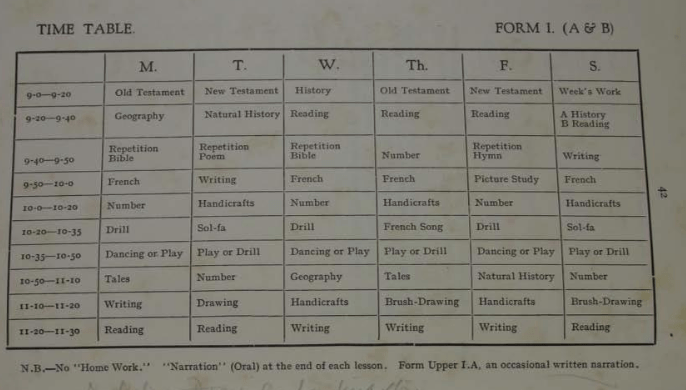
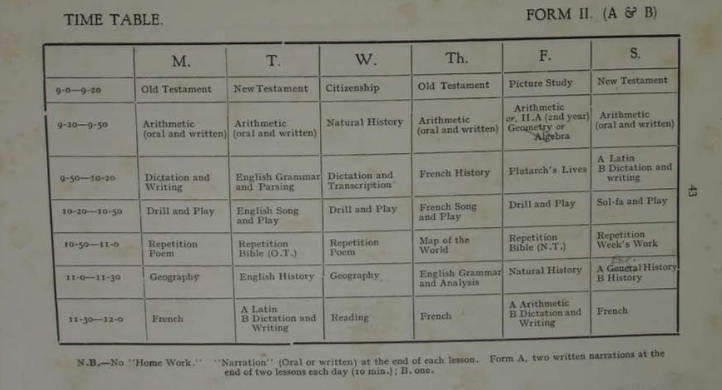
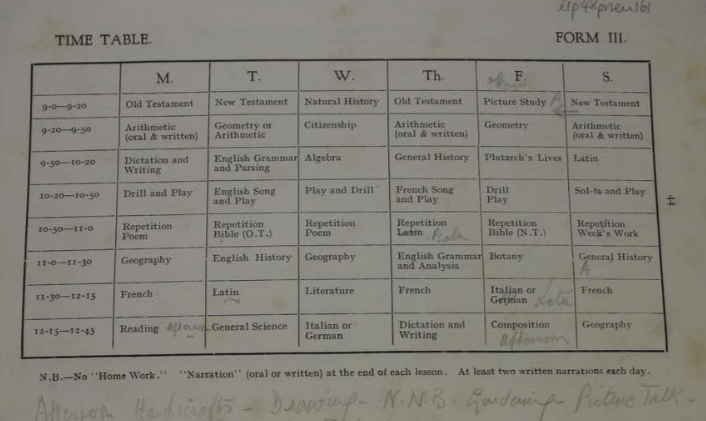
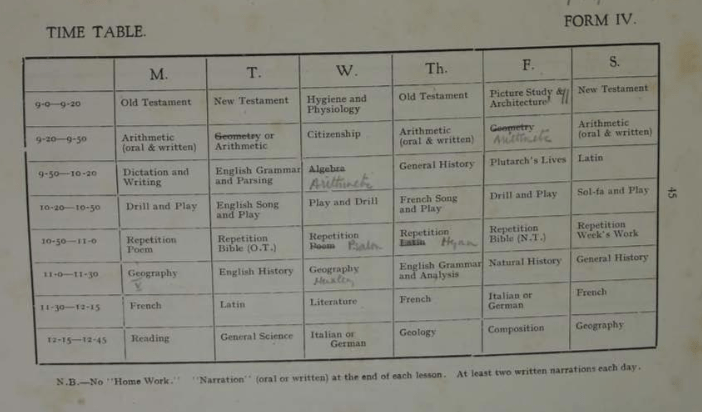
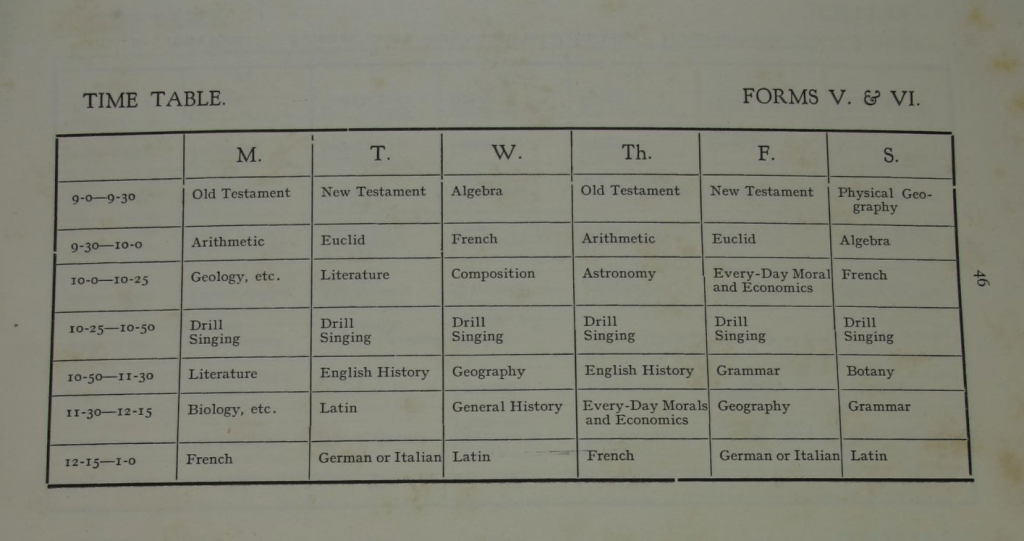
Another set of timetables differing from those posted above can be found here: http://amblesideonline.org/PR/PR19p899Timetables.shtml
Many “Programmes” containing each term’s work by form (grade) in Charlotte Mason’s schools can be found in the AmblesideOnline Library towards the end of the page. These programmes display the content of the education her students were expected to receive.
AmblesideOnline’s FAQ regarding fitting everything strictly into the Time-tables can be found here. And a post underscoring the importance of the programme fitting the child, not the other way around can be found here. And Brandy Vencel’s post Myth: CM homeschools ought to recreate the PUS timetables is another good perspective.
Lastly, On the Possibility of Doing P.U.S. Work While Keeping Strictly to the Time-Tables.
Nature Study
AmblesideOnline’s How to Do Nature Study – this page describes what it is and how to do Nature Study.
The following is an example of a nature notebook. It is unclear whether this is a student’s notebook or that of a teacher trainee’s notebook. In either case, it gives a good idea of what is contained in a nature notebook.
Here is a much more sophisticated teacher trainee’s notebook.
This Nature Study Lesson by Melissa Duffy was shared by Jeannette Tulis and outlines the dry-brush method and supplies for a nature study lesson in a classroom setting.
The Immeasureable Benefits of Nature Study a podcast episode on The New Mason Jar with Cindy Rollins and Naomi Goegan
Narration
On Narration – this blog post links to an in-depth article by Childlight on narration. Or you can find it directly here:
Is Sequencing and Ordering the Curriculum Important for Scaffolding Learning?
Copywork, Transcription, Dictation
This blog post describes the steps involved in teaching a child to spell and write: The How-to of Dictation.
Learning Curve Ruled font you can print cursive copywork from your computer.
Here is Brandy Vencel’s post on How I Create Copywork Sheets For My Children where she explains how she uses Educational Fontware software to print out cursive copywork sheets.
Spelling Wisdom is one option for dictation. Dictation can also be done for free by choosing your own passages from books at their spelling level.
Spelling Other Than by Dication by Nancy Kelly
Spelling by Dictation by Art Middlekauff – when you do dictation and your kids still can’t spell.
Uncovering the Logic of English – resource for parents of struggling spellers or older students. The phonograms and spelling rules which explain 98% of English words.
Sequential Spelling Possible option for struggling spellers to be done on alternate days alongside dictation.
Grammar
Grammar can be an intimidating subject to teach, but thanks to Cindy Rollins’ post, we can learn how to teach it in a fun, short lesson the whole family can learn from! The Beauty of Grammar and the Short Lesson.
Charlotte Mason Language Arts, Part I
Charlotte Mason Language Arts, Part II
Charlotte Mason Language Arts, Part III
Art
Of the study of Art Charlotte Mason wrote, ” appreciation is not a voluntary offering, but a debt we owe, and a debt we must acquire the means to pay by patient and humble study.” You can read more about Art Study on this post Some CM Thoughts on Art. You can find a list of prints CM students study on the AmblesideOnline Art Study list. You can also find links to worldwide art collections at Google Arts & Culture.
Recitation
Recitation is an art, “a buried jewel waiting to be discovered, or like an imprisoned spirit just waiting to be freed.” Recitation goes hand in hand with scripture, poetry, Shakespeare, reading living books, and even public speaking in future years to come. Learn more about this “art” on this post: Recitation, ‘The Children’s Art’
Book of Centuries
Charlotte Mason had her students make use of a Book of Centuries – much like the nature journal, it was a personal history journal for each student to keep what interested them from history. One might be interested in ships over the span of time while another in fashion, or weapons. The uniqueness of the BOC to each child’s interests made it something personal, fun to keep, and worth sharing between students. BOC’s were started in later elementary years.
This pamphlet describes the Book of Centuries and how to keep one. You can see the original here:
Setting up a BOC from scratch is complicated and hard to find adequate notebooks with the correct number of lines and blank pages, it is easier to purchase one. Laurie Bestvater’s BOC is recommended, it is a beautiful hardbound book. It is pricey, but used for many schooling years.
Living Book Press has a low-cost BOC option available, be careful not to get the featured BOC on their page – it skews time by altering the number of years per page from 100 to 50, to 20 to 10 as it heads towards modern years, which is not recommended because it distorts the child’s view of history. Adjustment in prehistoric times is less significant and unavoidable due to notebook space.
Charlotte Mason also used timelines in her classrooms. The Book of Centuries is not the same as this classroom timeline. You can find a pamphlet titled “Notes on Making a Timeline” here:
https://archive.org/stream/CM16FileCMC107i1-i4cmc107I/i3p1-p4cmc107I
Her schools also used “century charts” described and pictured here: https://archive.org/stream/CM16FileCMC107i1-i4cmc107I/i3p1-p4cmc107I
For more detailed information on these and other notebooks CM used, you can refer to The Living Page.
AMBLESIDEONLINE CURRICULUM
There are many curriculum choices out there. AmblesideOnline is one that can be recommended here as it is tried and true with many graduates who have successfully transitioned on to college, career, family, and beyond. It is also free and continually worked on by a faithful Advisory and Auxiliary group, rather than a sole individual or family. It is also not a “for-profit” entity so there are no quotas or financial needs influencing its existence or material choices.
Here is a video by Brandy Vencel that walks you through how to use the AmblesideOnline curriculum.
And here is a post by Brandy: Making AmblesideOnline Work: The Gory Details.
Literary Resources
Heritage History hosts a wealth of traditional, story-based history books for all ages.
Project Gutenberg is a library of over 60,000 free ebooks.
Audio Resources
Librivox.org – Free downloadable audios, many classics like the Bible, Pilgrim’s Progress, etc. are available, read by volunteers (some, like Cori Samuels, are really wonderful, some are not.) Here is a list of Librivox recordings of books on the AmblesideOnline curriculum list sorted by year. This may not be up to date.
Hoopla is another free audio resource contracted with your local library.
Middle/High School
AmblesideOnline’s High School Page with a lot of helpful information can be found here.
Beginning Later? Here’s a helpful page of information for anyone beginning Charlotte Mason’s methods/AmblesideOnline with an older child.
Beginning Charlotte Mason’s Methods with an Older Student by Karen Glass
HSLDA has a helpful page of information here including transcripts, dual enrollment, grading guidelines, and more.
High School Chemistry using Living Books by Nancy Kelly
Science with Living Books by Kelli Christenberry
Glenna Heustis’ talks at the 2019 SoCalCM Conference are specific to CM High Schooling in California: Navigating High School and Atmosphere, Discipline, and Life for High School and Beyond.
Glenna is also offering hourly consulting.
California Driver’s Ed Behind the Wheel Training Instructions. A little outdated, but contact me if you need updated info.
No family or child is immune to the dangers of the internet. Learn and educate yourself and your children by visiting Enough is Enough. 
Maven’s Navigating a World of Screens is a worthwhile investment to learn strategies for this age.
Read Greta’s posts.
Blogs
Archipelago by the AmblesideOnline Advisory
KarenGlass.net by Karen Glass
WendiWanders by Wendi Capehart
Afterthoughts by Brandy Vencel
Mere Motherhood by Cindy Rollins
Pineywoods Homeschool by Kathy Livingston
Joyous Lessons by Celeste Cruz
LivingCMinCA by Naomi Goegan
The Science of Relations & Wonder
What is the Science of Relations? Well, really, everything in a CM education. Karen Glass’ post “Education is the Science of Relations” is an excellent must-read for every CM parent.
Wonder is the seed of knowledge and a foundational element of much of CM’s methodology.
Click on the image and scroll down to find this episode by Angelina Stanford. It is accessible with a $2 subscription to patreon and is worth every penny!
The Distorted Image: Greek Mythology and the Gospel
Reading Greek Mythology as part of a CM curriculum we see many similarities between them and the Gospel stories. The secular world claims this proves the Gospel is myth. Angelina beautifully describes why it proves alternately towards the Gospel as truth.
Encouragement for Mothers

Creatures in Exile. A must-read post by Caitlin Beauchamp, written for the AmblesideOnline 2019 Conference.
God loves the unloved, He is full of grace and compassion. As homeschool moms, we can struggle with many trials through many seasons. The Girl Nobody Wanted: A Study of Leah is a sermon that I pray will encourage you and give you wisdom as you travel down this good path for your children’s sake. It was delivered to a group of women at a little seaside church in Laguna Niguel a few years ago.
Community
Visit our Community page here for a list of real-life and online communities.
PODCASTS
Circe Institute’s Mason Jar with Cindy Rollins – Cindy homeschooled a house full of boys and one daughter and now shares her wisdom on this series of podcasts with guest speakers each month and a Q&A inbetween.
Aftercast – Brandy Vencel’s Charlotte Mason podcast.
Sage Parnassus – Nancy Kelly’s Charlotte Mason podcast
Schole Sisters – A joint Charlotte Mason / Classical podcast for the homeschooling mama with Brandy Vencel, Pam Barnhill, and Mystie Winckler.
Flourish – Ambleside Schools Int’l podcast
Publications
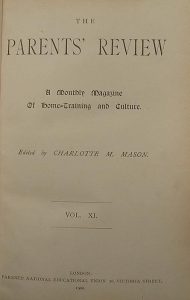
The Parent’s Review – Vintage articles from the Parents’ Review magazine edited by Charlotte Mason.
L’Umile Pianta – In 1895 the House of Education Old Students’ Association was formed to provide current and ‘old’ students who were scattered abroad, opportunities to keep in touch and provide mutual support. In 1896 they began publishing the magazine, L’Umile Pianta, named after a plant growing near Ambleside which Charlotte Mason admired for its ability to bend without breaking. The medals below depict the plant in their center and the words “For the Children’s Sake” around it.
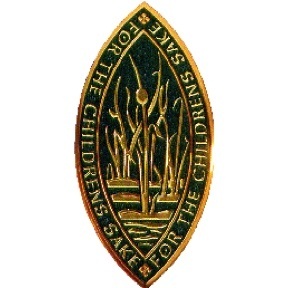

Commonplace Quarterly – Common Place Quarterly is a modern subscription based, quarterly print magazine designed and written by a team of dedicated CM moms. “It is a project that has brought together a variety of Mason mothers to create something of beauty and substance.”
GENERAL HOMESCHOOLING HELP AND INFORMATION
Statistics on Homeschooling – Can they get into college? Will they be socialized? Some statistics you may find helpful and ease your mind. Another article with stats here by HSLDA. And here is another good article on socialization.
Summary of Homeschool Laws – find out what is required to homeschool in your state.
100 Top Picks for Homeschool Curriculum – this book pointed me to a CM education for my children. If it points you somewhere else, please reconsider! I am hard pressed to believe anything other than a CM education is the best for any child, but I’m open to considering it 🙂
Revival of Learning – resources for newbies wanting to gain a foundational understanding of Charlotte Mason homeschooling with “done-for-you” helps.
